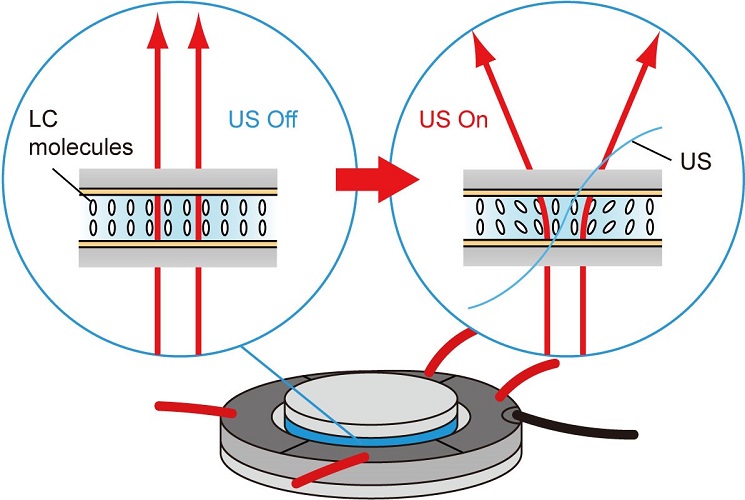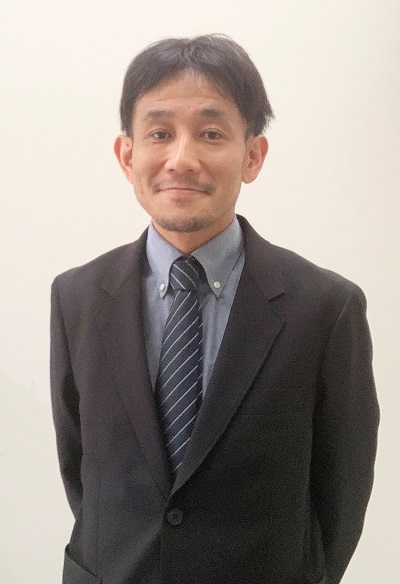Research News:Towards Next-Gen Indoor Lighting: Novel Tunable Ultrasonic Liquid Crystal Light Diffuser
August 22, 2024
Researchers developed a novel tunable ultrasonic liquid crystal light diffuser that allows changing the diffusion direction
In conventional light diffusers, optical characteristics such as diffusion angle and direction can only be tailored during fabrication and not after installation. Light diffusers that allow such changes can save energy and provide better indoor lighting aesthetics, but such devices are rare. In a new study, researchers have developed a novel tunable ultrasonic liquid crystal diffuser, that allows changing the diffusion direction using electrical inputs, while having a compact structure with no moving parts.
It is no mystery that light is essential to human life. Since the discovery of fire, humans have developed various artificial light sources, such as incandescent lamps, gaslights, discharge lamps, and light-emitting diodes (LEDs). The distribution and intensity of artificial lights indoors are important factors that affect our ability to study and work effectively and influence our physical and mental health. Consequently, modern artificial light sources are designed with these psychological elements to achieve the best aesthetics. LEDs, the most recent innovation in artificial light, have contributed to the development of environmentally friendly lighting systems due to their high efficiency. However, they tend to be smaller than traditional light sources, necessitating the use of diffusers to spread light over a larger area.
Conventional light diffusers have periodic surface profiles, periodic refractive index distributions, or light-scattering layers that direct and spread light in specific directions. The optical characteristics of these diffusers can be tailored during fabrication to meet specific requirements. However, once fabricated, these properties, including diffusion directivity, i.e. the direction of transmitted light distribution, cannot be changed. One method to control diffusion directivity after installation is to mechanically move the optical components, but this can increase the size of the device. Diffusers that enable control of diffusion directivity without using mechanical parts are rare.
In a new study, Professor Daisuke Koyama and graduate students, Mr. Yuma Kuroda and Mr. Ryoya Mizuno from the Faculty of Science and Engineering at Doshisha University, developed an innovative tunable ultrasonic liquid crystal (LC) light diffuser. Prof. Koyama explains, “Our ultrasonic LC light diffuser is based on the generation of non-coaxial resonant flexural vibration, which controls the molecular orientation and refractive-index distribution of the LC layer, providing control over diffusion angle and direction. It has a thin and simple structure with no mechanical moving parts.” Their device was detailed in a study published in the journal Scientific Reports on July 04, 2024.
The ultrasonic LC diffuser consists of a nematic LC layer sandwiched between two glass discs, and an ultrasonic piezoelectric transducer. The electrodes of the transducer are distributed in a circular pattern within the diffuser. Applying a continuous reverse-phased sinusoidal signal to the transducer produces ultrasonic vibration on the glass discs. When the frequency of this vibration matches the resonant frequency of the LC light diffuser, non-coaxial resonant flexural or bending vibration modes are generated on the LC layer at various frequencies. This results in differences in the acoustic energy between the LC layers, glass discs, and the surrounding air, inducing an acoustic radiation force acting at the LC layer and glass disc boundary. This effect changes the molecular orientation of the LC layers, altering the transmitted light distribution. By changing the electrodes to which the input voltage is applied, the direction of the molecular orientation and therefore the diffusion directivity can be easily rotated.
The researchers investigated the diffusion characteristics of the device and found that the diffusion angle depends on the input voltage amplitude and is maximized at 16 V. Above this voltage amplitude, the diffused light can become unstable. Additionally, the transmitted light distribution depends on the polarization of incident light.
“Light diffusers that allow control over diffusion directivity can reduce energy consumption and enable users to tune the light distribution to their taste, resulting in better aesthetics Our device marks the first report of an ultrasonically controllable optical diffuser based on LC material, providing users control over diffusion directivity within a small space,” remarks Prof. Koyama.
Indeed, this innovative device has the potential to revolutionize indoor lighting, contributing to enhanced and tailored aesthetics through controllable light diffusion.

Proposed ultrasonic liquid crystal light diffuser
Schematics of the LC molecular orientation and the transmitted light in the absence (left) and in the presence (right) of the ultrasound excitation. Red and blue curves represent the light and the ultrasound vibration, respectively.
Image courtesy: Daisuke Koyama from Doshisha University
Image license: Original content
Usage Restrictions: Cannot be reused without permission
Reference
| Title of original paper | Ultrasonic liquid crystal tunable light diffuser |
| Journal | Scientific Reports |
| DOI | 10.1038/s41598-024-66413-2 |
Funding information
This work was partly supported by Japan Society for the Promotion of Science (22H01391) and Tateisi Science and Technology Foundation.
EurekAlert
https://www.eurekalert.org/news-releases/1052561
Profile

Daisuke Koyama is currently a Professor at the Faculty of Science and Engineering at Doshisha University. He obtained his M.S. and Ph.D. degrees from Doshisha University in 2002 and 2005, respectively. He is currently a member of The Institute of Electronics, Information and Communication Engineers, The Japan Society of Applied Physics, IEEE, and the Acoustical Society of Japan. He is also a leading member of the Laboratory of Ultrasonic Electronics at Doshisha University. He has over 290 publications with over 1700 citations. His research interests include optical devices, applied measurement, and ultrasound.
Daisuke Koyama
Professor, Faculty of Science and Engineering Department of Electrical Engineering
Media contact
Organization for Research Initiatives & Development
Doshisha University
Kyotanabe, Kyoto 610-0394, JAPAN
CONTACT US
